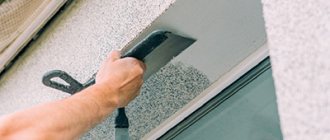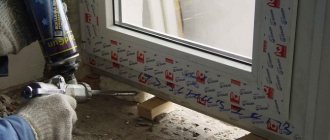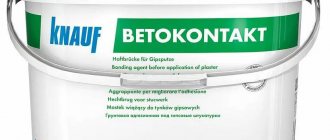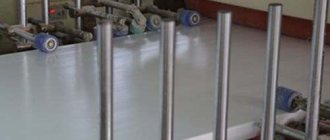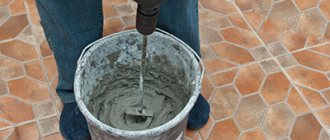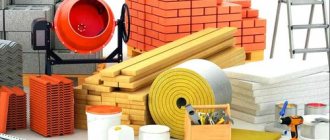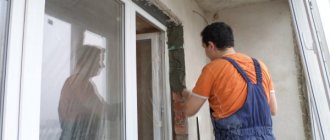Delivery to any city in Russia
Penetrating waterproofing for concrete with a wide range of applications and high waterproofing properties. The material is intended for protection and installation of internal and external waterproofing of concrete and reinforced concrete surfaces . The composition is a dry construction mixture based on Portland cement, aggregate and a complex of active chemical additives.
“HydroActiv” penetrating coating mixture is ready for use and can be applied using classical methods (following the example of coating waterproofing) both manually and mechanically. In this case, the thickness of the laid layer is minimal. Waterproofing properties are achieved due to the penetration of a complex of active chemical components of the composition into the treated surface under the influence of osmotic pressure and their further interaction with the components (minerals) of Portland cement with the formation of insoluble salt crystals. The growth of crystals goes deep into the structure.
This structure of new formations makes the treated surface waterproof. It is not recommended to apply the material to concrete of low and heterogeneous density (poorly vibrated concrete), to concrete with a low waterproof grade (below W2), to lime-cement and gypsum plasters, or to use it for waterproofing foam and aerated concrete.
TECHNOLOGY OF APPLICATION
Conditions of work
During the period of work and in the next 3 days, the ambient temperature should be in the range from +5ºС to +35ºС. The temperature of the mixture mixed to perform the work must be within the same limits +5ºС to +35ºС. The surface to be treated must be protected from precipitation and direct sunlight. When carrying out work in winter, air heaters should be used to maintain the required temperature conditions.
Preparing the base
The base for the applied material must be strong and clean. Visible cracks with a thickness of more than 3 mm should be expanded in the shape of a wedge with a groove size of 20 × 20 mm. Embroidered cracks should be dusted and moistened, then filled with repair material. Weak, peeling areas, as well as previously applied finishing materials must be removed. The surface to be treated must be cleaned of dust, dirt and other substances (oil, mold, cement laitance, etc.). These operations can be carried out either manually using steel brushes or mechanically using sandblasting or high-pressure water jets, electric drills, and hammer drills. When cleaning the surface, create a rough structure if possible. Before applying the HydroActive penetrating , the surface should be dust-free and moistened. The surface can be considered prepared if it is clean, has no weak areas, is sufficiently moistened and has an open capillary structure.
Preparation of the composition
“HydroActiv” penetrating coating material is used in the form of a mortar mixture. To prepare the mortar mixture, you should use drinking or industrial water with a temperature not lower than +15ºС. The amount of prepared material should be taken based on its complete production within 45 minutes and taking into account the consumption of 1 kg per 1 m2. A measured amount of water is poured into the working container: 0.6 per 1 kg of dry mixture or 15 liters per 25 kg bag. The dry mixture from the package is poured into the required amount of water for mixing and mixed for 3-4 minutes until a homogeneous dough-like consistency is achieved manually or mechanically using a low-speed drill (250 rpm) with a special attachment. The composition is ready for use, and the prepared mixture should be homogeneous, plastic, without lumps or foreign inclusions. During the work process, it is necessary to re-mix the mortar mixture without adding water.
Work order
“Hydroactive” penetrating coating material can be applied either manually or mechanically.
1. Manual method of application The material is applied to prepared surfaces using a brush or brush. The material should be applied in 2 layers. The second layer is applied 2-3 hours after applying the first. At high ambient temperatures, the applied 1 layer of material should be moistened. Material consumption depends on the degree of relief of the coating. If the work is carried out correctly, the material consumption should be 1 kg per 1 m2
2. Mechanical method The material is applied to the prepared surfaces by spraying with pneumatic spray guns with a working pressure of 5-6 Bar. The thickness of the applied coating must be at least 1 mm. The material should be applied in 2 layers. The second layer is applied 2-3 hours after applying the first. At high ambient temperatures, the applied 1 layer of material should be moistened. In this case, the mechanically applied coating has a more textured surface; if necessary, it should be rubbed down immediately after applying the layer using spatulas or graters. The average consumption of dry mixture is 1 kg/m2 per 1 mm of thickness.
Within 3 days and 8 hours after completion of work, the applied coating should be moistened 2-3 times a day, preventing it from completely drying out and actively evaporating moisture. Upon completion of the work, the quality of the coating should be checked. The hardened coating must be smooth, durable, and the continuity of the coating must be ensured (no untreated areas). Checking the quality of the device or restoration of waterproofing should be carried out no earlier than after 28 days. The surface treated with the dry mixture “HydroActive penetrating coating” is allowed to be used 3 days after completion of work. Subsequent work (for example finishing work, flooring work, etc.) should be carried out 14 days after surface treatment with preliminary cleaning of the surface from peeling and efflorescence.
CONDITIONS OF TRANSPORTATION AND STORAGE
"Hydroactive" universal coating" is packaged in paper bags with a capacity of 25 kg. The material should be stored in dry, closed warehouses, ensuring the safety of the manufacturer's packaging and preventing the material from getting wet. Transported in covered vehicles, protected from moisture and contamination. At ambient temperatures above +35 o C, it is recommended to protect the packaging from direct sunlight. The shelf life of the material is 12 months from the date of manufacture, subject to the rules of transportation and storage.
AquaNAST-A technical characteristics
The application has been successfully sent.
A manager will contact you shortly.
Science-Construction NPO, LLC
Water repellent “AquaNAST-S” (Nauka-Stroitelstvo NPO, LLC)
Application area
AquaNAST-S* – used to create hydrophobic coatings of building structures of buildings and structures, as well as to construct a barrier against capillary moisture (horizontal cut-off waterproofing
Typical applications
- external surfaces of building structures made of brick, concrete, aerated concrete, gypsum, natural stone, etc.;
- elements of buildings and structures (foundations, walls, floors, ceilings, vaults, etc.);
- underground and buried structures (parking lots, basements, shelters, pumping stations, etc.);
- piece materials (bricks, cinder blocks, aerated concrete blocks, etc.);
- prevention of efflorescence of brick, concrete, plaster, gas and foam concrete, fiberglass board, gypsum, slate, ceramics, natural stone, working in harsh climatic conditions.
AquaNAST* water repellents are used to protect capillary-porous building materials from water by modifying the structure (volumetric hydrophobization) or surface treatment of building structures. For hydrophobization, the “AquaNAST” composition of grade “C” is used, which is a multicomponent aqueous solution of silicone (organosilicon) concentrate with bridging additives.
AquaNAST-S is applied to surfaces made of concrete, mortar, ceramic and silicate brick masonry, and natural stone to give them water-repellent properties. With volumetric hydrophobization, the composition is added to concrete and mortars with mixing water, and to brickwork - by injection through holes.
Water repellent AquaNAST-S* is a multicomponent aqueous solution of silicone concentrate based on silanes and oligomeric siloxanes with bridging additives. After application, it forms a thin water-repellent coating in the surface layer. With volumetric injection, clogging of the pores of the building structure occurs, and the surface of the pores is modified, preventing further seepage (or suction) of water from the outside.
Specifications
| Appearance | colorless liquid |
| Density, kg/m2 | 1050 |
| Active substance content, %, mass | 7,5 |
| Hydrophobicity coefficient after 100 cycles | 1,8-2,0 |
| Water absorption of the sample with volumetric injection, % | 8-10 |
| UV resistance | steadfastly |
| Consumption for surface treatment, kg/m2 | 0,8-1,0 |
| Consumption for cut-off waterproofing, kg/m 3 | 75-10 |
| Guaranteed shelf life, months | 12 |
Instructions for use
Preparing the base
During work, the temperature of the insulated surface should not be lower than +5°C. No visible cracks are allowed on the insulated surface. Remove weakened and fragile areas of the surface mechanically.
The surface must be cleaned of substances that reduce the adhesion of the solution to the surface (dirt, oil, bitumen, etc.). Water repellent AquaNAST-S should be applied to a dry base. Do not carry out work during or immediately after rain!
Anti-capillary cut-off
The holes for injection are being arranged: the diameter of the holes is 16-18 mm, the distance between centers is 12-15 cm, the depth is 2/3 of the wall thickness. If there are large cavities, hollow bricks, cracks or cavities in the walls, then before injection the holes are filled with cement mortar with the multifunctional additive AquaNAST-O in a ratio of 1:10.
Preparation of the solution
The composition is supplied ready for use. When working, you must use safety glasses, rubber gloves and an apron. Avoid contact of the solution with mucous membranes of the eyes and mouth. If it gets on your skin, wash it off with plenty of water.
Application of the composition
The composition is applied manually with a brush, roller or mechanically using a pneumatic spray gun. To avoid gaps, it is recommended to apply the material in 2-3 layers, with an interval of 10-15 minutes.
Quality checks are carried out 48 hours after processing; Water should drain from the surface without being absorbed.
Pressure injection is recommended when the masonry being treated is saturated with moisture. Injection is carried out by a pump with AquaNAST-S supply through hoses from the container to the injectors. Holes during injection are sealed using fittings and rubber bushings installed on the injectors, or using packers. During non-pressure injection, AquaNAST-S is poured into the borehole from a special container (funnel with a valve). The impregnation time must be at least 8 hours, then the holes of the drill holes are plugged.
Source: digest.wizardsoft.ru
Operating principle
The operation of the station is based on the joint operation of the pump, accumulator, pressure gauge and pressure switch.
It looks like this:
- When first started, the pump begins to pump water, filling the system and the accumulator;
- A hydraulic accumulator is a sealed tank with a membrane inside. When it is filled, water gradually displaces air, creating pressure on the membrane;
- When the pressure reaches a certain value, a relay is activated, which turns off the pump;
- When the tap is opened, the water in the accumulator decreases and the pressure drops;
- At the minimum set pressure, the relay is activated again, this time turning on the pump, which pumps up water, preventing the pressure in the network from falling and filling the tank after closing the tap.
This is how not only Aquario pumping stations work, but also all similar installations. This is by far the best way to create automatic water supply in places where there is no centralized water supply.
Scheme of water supply from different sources
With the help of such stations, you can not only ensure comfortable living in a country house, but also solve the problems of irrigation (see Selecting a pump for irrigation in the country), supplying water to farms, etc.
Advantages
- The dry waterproofing mixture “Gidrosmail Coating” is manufactured in accordance with the requirements of GOST 31357-2007.
- Has a high degree of adhesion to the base.
- The dry waterproofing mixture “Gidrosmail COATING” is impermeable to liquids, but vapor permeable.
- It is highly resistant to aggressive environments and sea water.
- Can be applied manually or mechanically.
- The dry waterproofing mixture “Gidrosmail COATING” is applied to a damp surface.
- Hardens in damp, enclosed spaces with rapid strength gain.
- Does not contain solvents or other substances hazardous to health.
- The solution is mixed with tap water.
- The dry waterproofing mixture “Gidrosmail COATING” and its solution are an environmentally friendly product.
- Contact with drinking water is allowed.
Delivery terms
- We will deliver tomorrow or the day after tomorrow (after confirmation by the operator)
- We deliver from 10:00 to 20:00 from Monday to Friday. Items ordered on Saturday and Sunday are delivered on Monday
- Upon receipt of the goods, you must check the contents and appearance of the goods in the presence of the courier. The company is not responsible for incompleteness and damage to the goods (including mechanical) after acceptance of the goods by the client
- We ask you to remember that you should check all technical parameters and consumer properties of the purchased product with our manager before purchasing the product. The courier does not have information about the product (technical characteristics, product contents)
Dry mixtures for waterproofing
Waterproofing of buildings and structures under construction and existing ones is an eternal problem. Today, interesting and unusual new materials are appearing on the city market - special dry building mixtures. When choosing them, an integrated approach is required to assess all the advantages and disadvantages.
Main characteristics of SSS “AquaNAST”
First of all, it should be noted the relevance of the problem of introducing dry building mixtures (DCMs) specifically for waterproofing purposes and specifically at the present time in St. Petersburg. This is due to the following reasons.
Firstly
Since 2000, the city has been intensively developing basement spaces. Everywhere, especially in the prestigious center, there are restaurants, cafes, shops, warehouses and other business facilities. In this case, the task? 1 for the tenant - turn a wet or water-filled basement into a dry room.
Secondly
, in the future, the process of developing basements will not only continue, but also increase due to increased investment in our metropolis.
Third
, the city is aging, which means basements, plinths, blind areas and walls are being destroyed. They need to be protected from rain, snow, ice, and melt water. In addition, the number of emergencies, both natural and man-made, will constantly increase. Any builder knows: the roof collapses - it needs to be replaced, and the foundation collapses - the whole building fails. To prevent such collisions, it is advisable to use dry construction mixtures.
A review of the CCC market for waterproofing in St. Petersburg as of March 2003 shows that there are quite different modifications of such waterproofing compounds.
Dry mortar cement mixtures “AquaNAST”. Developed by NPO “Science for Construction”. Designed for waterproofing capillary-porous building materials - heavy, light, fine-grained, cellular concrete and brick. They are dry mixtures based on Portland cement, quartz sand and chemical additives. The following grades are produced: “O” – additive for concrete and mortars; “U” – standard paint composition; “A” – elasticized paint composition with increased crack resistance; “B” – elasticized paint composition. The main characteristics of the mixtures are presented in the table. Indicators 4-5 are given for a hardened solution with the addition of a mixture of grade “O” at the age of 28 days.
As experience in their use has shown, the mixtures do not impair the color characteristics of concrete and its frost resistance. Its adhesion after 28 days is at least 0.5 MPa to concrete, crack resistance is at least 0.2-0.4 mm, and water resistance increases by 4-6 steps.
Waterproofing mixtures “CMID”. Developed by JSC “NP TsMID”. Their distinctive features are that they are designed to restore defective layers of concrete operating not only in ordinary, but also in especially harsh conditions of aggressive water, temperature changes and shock loads. These SSS have been known for about 10 years, but are constantly evolving and by 2003 they already had 11 types of compositions. It should be noted their wide range of activities: self-leveling floors, repair and plaster compositions, masonry mortars.
Material system “GidroTEKS” from the company “Spetsgidrozashchita”. When mixed with water, a hydraulic solution is formed, which is applied to the wet surface to be protected. The principle of operation is the penetration of chemically active substances into the capillary-porous structure of concrete under the influence of osmotic pressure. There they interact with the cement stone and form insoluble crystals that fill the pores and capillaries, blocking the access of water, but not air. A study of the properties of these mixtures showed that the depth of penetration into concrete can reach 100 mm or more with a continuous front. There are 4 modifications of the mixtures available: “Universal”, “Regenerating”, “Antifungal” and “Quick-hardening”. Particularly interesting is the use of mixtures in tunnels, mines, pumping stations, sewers and bomb shelters in St. Petersburg.
“Aquatron-6” mixtures, introduced by TD “SIAC”. Adding 3% of the material to building mixtures turns concrete into a waterproof composition and increases its service life several times. Due to what? Tests of this mixture have shown that micropenetration of the sealant extends into concrete to a depth of 30 cm. At a consumption of about 1.5 kg/sq. m of treated surface, concrete can withstand water pressure of up to 2 atmospheres - and this guarantees dry basements. It is important that the mixture is non-toxic, and its hygienic certificate allows its use even in drinking water storage facilities. In addition, it is advisable to use this sealant in holiday villages where there are wells, boreholes and wastewater treatment plant tanks.
Dry waterproofing plaster mixture aquanast gsh Delivery in Moscow and Moscow Region
The price of dry plaster offered by the Miramall hypermarket is affordable to any customer, and the quality is always impeccable, since the store directly cooperates with world-famous construction manufacturing companies: Knauf, Bergauf, Ivsil, Yunis, Osnovit and many others.
Dry plaster is a very popular and in-demand product on the Russian construction market. Lime, clay or cement plaster has been used by mankind since ancient times. In the modern world, the compositions of mixtures have become more complex, the quality has increased and the technical characteristics have expanded, which makes it possible to expand the functionality of plaster mixtures. They are usually classified according to their binder base, resistance to moisture and price.
The store's catalog offers different types of plaster mixtures: - gypsum, - cement, - cement-gypsum, - facade, - moisture-resistant.
On the pages of the online store you can buy plaster that is suitable for any surfaces and premises. In the catalog you can not only find out the technical characteristics of the product, but also read recommendations for use, which will help you choose the most suitable type of product.
- Adhesive mixture - used to secure the insulation layer.
Each of these types of plaster has its own advantages and disadvantages. Let's look at them in more detail.
- high hardening speed;
- plastic;
- crack resistance;
- not subject to shrinkage;
- uniform hardening;
- do not spread during application;
- economical consumption;
- do not require additional putty.
- can only be used in dry rooms (they are destroyed by moisture);
- prone to abrasion, low impact resistance;
- the period of work is strictly limited in time (due to the high solidification rate). Dry waterproofing plaster mixture aquanast gsh plaster mixture Knaufplaster mixture foundation
Differences in compositions based on the binding base
The largest and most common group of materials. The main component is cement, but in some cases other polymer-based binders may be added to the composition. River sand is used as filler. The main advantage is low cost. In addition, cement compositions are very convenient to work with because they harden quite slowly, which allows you to prepare a large amount of the mixture at once.
Cement plaster mixture
It should also be said about the high strength of the resulting surface. Among the disadvantages, one can note the long time to gain strength, which can reach 28 days. The finishing process using such material is associated with the formation of large amounts of dust and other contaminants.
Such plasters are valued for their high levels of biological hazard, due to which fungi, mold and pathogenic bacteria practically cannot grow on such surfaces. In addition, thanks to its excellent adhesion, this material can be used with any type of substrate. The material is easy to install and hardens quite quickly; it can be used without additional insulation, provided it is finished in a large layer.
We offer to buy penetrating waterproofing “HydroActiv” penetrating coating
Delivery to any city in Russia
Penetrating waterproofing for concrete with a wide range of applications and high waterproofing properties. The material is intended for protection and installation of internal and external waterproofing of concrete and reinforced concrete surfaces . The composition is a dry construction mixture based on Portland cement, aggregate and a complex of active chemical additives.
“HydroActiv” penetrating coating mixture is ready for use and can be applied using classical methods (following the example of coating waterproofing) both manually and mechanically. In this case, the thickness of the laid layer is minimal. Waterproofing properties are achieved due to the penetration of a complex of active chemical components of the composition into the treated surface under the influence of osmotic pressure and their further interaction with the components (minerals) of Portland cement with the formation of insoluble salt crystals. The growth of crystals goes deep into the structure.
This structure of new formations makes the treated surface waterproof. It is not recommended to apply the material to concrete of low and heterogeneous density (poorly vibrated concrete), to concrete with a low waterproof grade (below W2), to lime-cement and gypsum plasters, or to use it for waterproofing foam and aerated concrete.
Special modifications "Aquatron-6"
“Aquatron-6 white” is a penetrating waterproofing mixture for repair, restoration and preventive work on white cement. Its properties are completely similar to the Aquatron-6 mixture. Created to improve the decorative properties of the coating.
“Aquatron-6U” is a penetrating composition with increased crack resistance, reinforced with polymer fiber for sealing joints and seams of structures.
“Aquatron-6P” is a composition characterized by the fact that its working solution is more plastic, does not have a tendency to slide off vertical surfaces, can be applied mechanically, has the property of water retention, and therefore is less prone to premature drying.
To ensure the waterproofness of monolithic concrete and reinforced concrete structures at the concreting stage, we have developed a concentrated waterproofing material “AQUATRON-12”. Effective protection against leaks on any concrete structures will be provided by the waterproofing mixture “AQUATRON-8”
Main indicators of dry mixture quality
Gray powder
shade is not standardized
Humidity, %, no more
Largest grain size of filler Dmax, mm, no more
Content of grains of the largest coarseness, %, no more
Main indicators of the quality of a ready-to-use mixture
Setting time, hour:
- beginning, not earlier
- end, no later
Mixing water consumption, l/kg (g/kg)
Consumption of dry mixture for preparing 1 m³ of mortar mixture, kg
Main indicators of the quality of the hardened solution
Compressive strength of the material, MPa, not less
Water resistance of material W, grade, no less
Frost resistance of material, cycles, not less
Increasing the grade of concrete treated with the composition in terms of frost resistance, grade, no less
Increasing the water resistance grade of concrete treated with the composition under direct water pressure, steps, not less
Increasing the water resistance grade of concrete treated with the composition, with back pressure of water, steps, not less
Strength of adhesion to concrete base (adhesion), MPa, not less
Resistance of concrete of the protected structure to leaching
(1 type of corrosion), time of destruction of a layer 3 mm thick, years
Increasing the corrosion resistance of concrete of the protected structure in an acidic environment (pH ≥3) (2nd type of corrosion), times
Sulfate resistance (3rd type of corrosion), degree, not less
